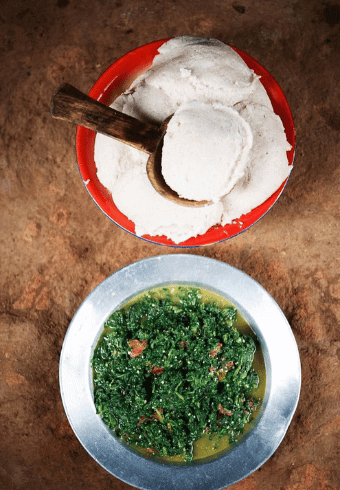Introduction
There are many Tanzania famous food dishes, and some are widely recognized because they are shared across neighboring countries—such as chapati, biryani, and pilau. But what makes them truly stand out in Tanzania is the nation’s deep-rooted history of cultural fusion, shaped by centuries of interaction with Arab, Indian, and Persiancommunities. These international culinary influences have blended seamlessly with indigenous traditions to create the flavorful, comforting, and vibrant cuisine that defines Tanzania famous food today.
Some Tanzanian foods are so prevalent that they’ve become part of daily life and are visible on every street corner—like chips mayai (French fries cooked with eggs), ugali (a maize-based staple), or wali na maharage (rice and beans), often served piping hot by beloved Mama Ntilie vendors. These dishes don’t just feed the people; they feed the culture, creating a shared identity across towns, cities, and regions.

It’s also important to note that certain dishes are region-specific, making the food landscape of Tanzania even more unique. For example, ugali is a mainstay in mainland Tanzania but is far less common on Zanzibar Island, where lighter, seafood-rich options are more dominant. In contrast, urojo, a tangy, spicy street soup known as “Zanzibar mix,” is hugely popular in Zanzibar but rarely found inland.
The Tanzania famous food dishes we will explore in this guide represent the heart of Tanzanian cuisine, each one offering a delicious window into the country’s diverse and flavorful soul.
1. Ugali – The Most Popular Tanzania Famous Food You Must Try
Ugali is the most widely eaten and culturally significant Tanzania famous food. Made from maize flour and water, this stiff, dough-like dish is the national staple across the country. It’s eaten daily in almost every home, making it not just food, but a way of life in traditional Tanzanian cuisine.

With its firm, polenta-like texture, Ugali is served alongside a variety of stews, meats, and vegetables, such as Matembele, Mchicha , beans, or Nyama Choma (grilled meat). It’s traditionally eaten with the hands—rolled into small balls and used to scoop up side dishes. In rural village, a street-side Mama Ntilie Banda, or a high-end restaurant in Dar es Salaam, Ugali is always on the menu.
What sets Ugali apart in Tanzania famous food culture is its versatility and accessibility. While maize flour is the most common base, it can also be made from sorghum, millet, or cassava flour, depending on the region and availability. This makes it adaptable to different tastes and nutritional needs across Tanzania.
Ugali’s popularity also varies by location. On mainland Tanzania, it’s eaten in nearly every household, often twice a day. In Zanzibar, however, it’s less common, where dishes like Urojo and seafood curries are more dominant. Still, across the country, Ugali remains the undisputed king of Tanzanian dishes.
Its preparation is simple but requires skill: maize flour is gradually added to boiling water, stirred continuously until it thickens and pulls from the sides of the pot—a technique passed down through generations. A perfectly cooked Ugali should be firm enough to shape but soft enough to scoop.
If you’re exploring traditional food in Tanzania, Ugali is a must-try. It’s filling, affordable, and deeply symbolic of the Tanzanian way of life. Whether you’re looking to taste authentic Tanzania famous food, gain energy for a long day, or share a meal with locals, a plate of Ugali is your gateway into Tanzanian culture and hospitality.
2. Chips Mayai – The Irresistible Tanzanian Street Omelet
Chips Mayai, also known as Zege, is one of the most iconic Tanzania famous food dishes—a street-style omelette made by combining crispy French fries with beaten eggs and frying them together until golden. Found across Tanzanian cities like Dar es Salaam and Arusha, it’s served hot with kachumbari (tomato-onion salad), tomato sauce, and often paired with fried or grilled chicken, mishkaki (spiced beef skewers), ukwaju (tamarind sauce), or mayonnaise for extra flavor.
This popular dish isn’t just beloved for its taste; it represents the deep connection between Tanzanian households and the poultry sector, where eggs symbolize nutrition, food security, and rural income—nearly every family raises chickens. Quick to cook, filling, and affordable, Chips Mayai is the go-to meal for students, workers, and anyone craving an easy, flavorful bite of authentic Tanzanian street food.
3.Pilau – Fragrant Rice Bursting with Spices

Pilau is a spiced rice dish and a cornerstone of Tanzania famous food, known for its deep aroma, rich flavor, and cultural significance. Made with rice, beef or chicken, and fragrant spices like cumin, cloves, cardamom, cinnamon, and garlic, Tanzanian pilau is always infused—not layered—creating a warm, uniform taste that sets it apart from Indian or Middle Eastern versions.
More than just a meal, pilau is a symbol of celebration in Tanzania. It’s traditionally served during holidays, weddings, religious festivals like Eid, and even Friday or weekend family gatherings. Growing up, pilau was the dish you looked forward to on special occasions—something truly worth waiting for.
Unlike biryani, which can sometimes be vegetarian and is layered in style, Tanzanian pilau is usually mixed directly with meat or chicken, making it very hard to find a vegan version at local eateries. In Tanzania, it’s almost always prepared with meat—beef being the most common, followed by chicken. If you’re vegetarian or vegan, the best option is to buy local Tanzanian spices and make your own homemade version to savor the same soul-warming flavor without missing out.
3. Biryani – A Zanzibar Jewel of Tanzania Famous Food with Deep Indo-Arab Roots
Biryani is one of the most flavorful and historic dishes in Tanzania famous food, especially known across Zanzibar. Unlike pilau, which is infused and simple, biryani is layered rice cooked with marinated meat (usually chicken, beef, or goat), potatoes, and a richly spiced gravy, then steamed for the flavors to beautifully meld together.
In Tanzania—particularly on the coast—biryani is more than a meal; it’s a celebration. Though it’s not as common in the mainland compared to Zanzibar, many locals traditionally enjoy biryani every Friday, and it’s a must-have at weddings, Eid, and family feasts. The Zanzibar version reflects centuries of Indian and Arabic influence, arriving through the spice trade routes and evolving into a unique blend of Afro-Indian culinary heritage.
Did you know? The word “biryani” comes from the Persian words birian (fried before cooking) and birinj (rice). Zanzibar’s strategic port, Unguja, was once a trading hub for spices, ivory, and sadly, the slave trade—this history shaped its distinct, elegant cuisine, and biryani is the crown jewel.
The dish is complex to prepare but worth the effort. Layers of rose-scented basmati rice, tender chicken or beef, and soft potatoes are cooked with spices like cardamom, cinnamon, cumin, saffron, cloves, and tomato-based sauce. Garnished with fried onions, mint, and ghee, Tanzanian biryani is soft, aromatic, and deeply satisfying. It’s often served with raitamade from yogurt and preserved lemon for contrast.
While biryani rice can be made vegan or vegetarian, the rich sauce it’s layered with in Tanzania is almost always meat-based, typically including chicken or beef stock. However, some restaurants—especially in tourist areas or Zanzibar—may offer a vegetarian sauce option upon request. If you’re vegan or vegetarian in Tanzania, it’s best to ask the restaurant specifically whether they can prepare a full plant-based version. For the most reliable experience, buy authentic Tanzanian spices and recreate a delicious veggie biryani at home, capturing the same fragrant, celebratory flavor without the meat.

4. Wali na Maharage – Tanzania Famous Food Combo of Rice and Beans

Wali na Maharage, meaning rice and beans, is one of the most beloved and widely eaten dishes in Tanzania famous food culture. It’s the ultimate comfort combo—fluffy white rice cooked with a touch of oil, paired with slow-simmered beans that are often flavored with onions, tomatoes, or carrots. On the Swahili coast, the beans are typically enriched with creamy coconut milk, giving them a rich, unforgettable taste.
While ugali is more common in many homes due to its affordability, wali na maharage is seen as a special dish—often served when rice is available, especially in urban areas or during gatherings. In many Tanzanian families, rice and beans feel like a celebration, not just a meal. And in boarding schools across Tanzania, this dish is the top dinner choice—many students remember eating it up to six times a week, a nostalgic reminder of simpler days.
Affordable, filling, and packed with protein and fiber, wali na maharage is not just a staple—it’s a symbol of traditional food in Tanzania. It’s commonly eaten for lunch or dinner, both in rural homes and busy city centers, and it’s a favorite at Mama Ntilie stalls and local eateries.
To create a more balanced plate, many Tanzanians pair rice and beans with vegetables, fish, or meat stew. When served with chapati or fresh avocado, it becomes a nutrient-rich, wholesome meal that satisfies every appetite. Simple yet powerful, wali na maharage is a true reflection of Tanzanian home cooking—unpretentious, nourishing, and full of heart.
5. Chapati – Tanzania Famous Food with East African Flavor and Indian Origins
Chapati is a thin, soft, and flavorful flatbread that has become a breakfast staple and street food favorite in Tanzania famous food culture. Originally of Indian origin, chapati has been widely embraced across East Africa and is now a beloved part of daily life in Tanzania, especially when served with maharage (beans), sweet tea, or coconut-based stews.
In Tanzania, chapati is most commonly enjoyed in the morning or evening, often sold by women street vendors or at local Mama Ntilie food stalls. In many homes, breakfast includes chai (spiced tea) and freshly made chapati, often served with vitumbua (rice cakes) or maandazi (fried dough), both popular East African morning snacks. These simple yet filling meals reflect the warmth and practicality of Tanzanian cuisine.

While chapati in India is often plain or served with curries, in Tanzania it has taken on a life of its own—slightly thicker, more oily, and irresistibly chewy. On the coast and in upcountry areas, it is enjoyed with beans, lentils, vegetables, or even meat stews, depending on what’s available. Although meat is more common in wealthier or livestock-owning households, chapati remains affordable and accessible to nearly everyone.
Tanzania’s cuisine may not be the most diverse, but it’s incredibly rich in flavor thanks to fresh tropical ingredients and Swahili, Indian, and Arabic influences. Chapati is the perfect example of this fusion—simple in ingredients, yet deeply rooted in both history and daily life.
Whether eaten as breakfast, lunch, or dinner, chapati is a key part of Tanzania famous food, connecting generations and communities one soft, golden round at a time.
6. Supu ya Pweza – Tanzania Famous Food from the Sea with Coastal and Cultural Depth
Supu ya Pweza, or spicy octopus soup, standout as a Tanzania famous food, especially along the Swahili coast and Zanzibar, where seafood reigns supreme. Made from tender chunks of octopus simmered in coconut milk, tomatoes, garlic, onions, ginger, and a warm blend of spices, this aromatic soup captures the essence of Tanzania’s deep coastal connection to the Indian Ocean.
Often finished with a splash of lime or tamarind for tanginess, Supu ya Pweza is not only delicious,it’s also packed with nutrition. Octopus is high in lean protein, omega-3s, and vital minerals, making this dish a favorite for health-conscious locals and seafood lovers alike.

While Zanzibar is its spiritual home, octopus soup is also growing in popularity on the Tanzanian mainland, particularly in the evenings near bus stops and busy intersections. In these spots, vendors set up simple tables, serving hot bowls of Supu ya Pweza, often alongside squid, and snacks like kachori and bagia. It’s not uncommon to see long lines of men waiting, as the soup is popularly believed to boost male virility and energy, a belief that adds to its appeal and cultural significance.
Supu ya Pweza is one of the most exciting and flavorful examples of traditional Tanzanian cuisine. It’s bold, rich, and unforgettable, offering a taste of the sea with every sip.
7. Urojo – Zanzibar’s Iconic Vegan Street Soup and Tanzania Famous Food Stapleibar Mix Bowl
Urojo, popularly known as Zanzibar Mix, is one of the most vibrant and flavorful dishes in Tanzania famous foodculture. This spicy, tangy, golden soup is a street food staple in Zanzibar—especially at the legendary Forodhani Gardens in Stone Town—where it’s sold nightly by local vendors to lines of eager customers. If you’re visiting Zanzibar, Urojo is an absolute must-try.
The base of Urojo is a thin, turmeric-infused broth made from flour, mango, lime, and a blend of aromatic East African and Indian-inspired spices. Into this lively soup goes a mix of crispy and soft toppings: potato bhajias, mashed potatoes, cassava chips, red and coconut chutneys, and sometimes small meat skewers (mishkaki) or a boiled egg. It’s finished off with crunchy toppings and fresh herbs for a multi-textured bite

While it can be topped with egg or meat, Urojo is naturally vegan at its core—all its main ingredients, including the soup and toppings, are plant-based. This makes it one of the few Tanzania famous foods that is fully vegan-friendlyand customizable based on personal preference.
Though Urojo is available at some restaurants in cities like Dar es Salaam, it is most famously enjoyed in the open-air coastal evenings of Zanzibar, where its Swahili-Indian fusion truly shines. Part soup, part snack, part full meal—Urojo isn’t just food, it’s a flavor-packed experience that perfectly reflects Tanzania’s street food culture and its rich, multicultural history.
8. Utumbo wa Kuku – Tanzania Famous Food That Proves Nothing Goes to Waste
In Tanzania, the only part of the chicken that’s thrown away is the feathers—everything else is eaten. And one of the most beloved examples of this no-waste culinary culture is Utumbo wa Kuku—chicken intestines. Though lesser-known to tourists, this flavorful, chewy delicacy is a favorite among locals and a true gem in Tanzania famous food traditions.

Utumbo wa kuku is carefully cleaned, boiled, and then either grilled, fried until slightly crispy or slow-cooked with onions, tomatoes, garlic, and light spices. The result is rich, savory, and bursting with umami—a street food treat that’s best enjoyed with ugali, rice, or paired with a crunchy kachori. In Dar es Salaam, you can even find restaurants that specialize in utumbo wa kuku, often serving it with a side of hot sauce and an ice-cold soda or beer. It’s a local favorite, especially in bars, roadside eateries, and market stalls.
Vendors across Tanzania often offer fried chicken intestines, along with other underrated but tasty cuts like gizzards and hearts—parts that many locals argue are the most delicious pieces of the chicken. If you think you love chicken, wait until you try utumbo wa kuku. The chewy texture, the deep fried flavor, and the spices make it an unforgettable bite for those willing to explore the full spectrum of traditional food in Tanzania.
Utumbo wa kuku might not be for everyone, but for the adventurous foodie or anyone seeking to eat like a true local, this dish offers a bold, protein-rich, and culturally authentic experience you won’t find in guidebooks—but you’ll definitely find on Tanzanian plates.
9. Makange – A Spicy,Satisfying Tanzania Famous Food , Meat Lover’s Favorite

f you’re looking to spice up your culinary adventure, Makange is one of the boldest and most flavorful dishes in Tanzania famous food. Known for its rich aroma and spicy bite, Makange is a dry-style meat dish made by frying marinated beef, chicken, goat, or even fish with onions, carrots, bell peppers, and Tanzanian spices until perfectly tender and juicy.
Unlike traditional stews, Makange is not watery. It’s stir-fried to lock in flavor, allowing you to taste the sweetness of carrots, the bite of paprika, and the savory richness of spiced meat—all in one plate. It’s the perfect balance of heat, depth, and texture.
While you won’t usually find Makange at your typical Mama Ntilie food stall, it has become a favorite in urban restaurants and street grills, especially in lively areas like Coco Beach in Dar es Salaam, where it’s often served in shareable platters. It’s a go-to dish in pubs, weekend joints, and special dining spots where flavor and presentation meet.
Makange is best enjoyed with ugali, rice, or chapati, and it pairs beautifully with a cold drink or fresh salad on the side. Whether you’re dining with friends or just craving something spicy and satisfying, Makange offers a true taste of authentic Tanzanian food beyond the usual.
10. Nyama Choma – The Pride of Tanzanian Grilling and a True Tanzania Famous Food Icon
Nyama Choma, meaning “grilled meat” in Swahili, is more than just food—it’s a social ritual and national obsession. As one of the most celebrated dishes in Tanzania famous food culture, this charcoal-roasted meat—typically goat, beef, or chicken—is a weekend staple, a bar snack, a party centerpiece, and even the focus of entire festivals dedicated to its smoky, mouthwatering glory.
Prepared with minimal seasoning—often just salt or a light marinade—the emphasis is on the natural flavor of the meat, enhanced by a slow, open-fire grilling process. That said, in many places across Arusha, Dar es Salaam, and Mwanza, you’ll find Nyama Choma rubbed in curry, masala, ginger, tikka, or other spice blends, and sometimes marinated for hours to achieve extra tenderness and taste.

Nyama Choma is commonly served hot off the grill with kachumbari (a fresh tomato-onion salad), ugali, chips, or even alongside wali na maharage (rice and beans). You can get it as T-bone steak, mishkaki (meat skewers), or as large, juicy cuts meant to be shared among friends.
This dish is a bar culture essential—it’s often said in Tanzania that if you want to avoid a beer belly, you should drink beer with Nyama Choma, not with chips or snacks. It’s that serious. And rightly so: the smoky aroma, crispy edges, and tender meat make every bite worth the wait.
Nyama Choma represents the joy of togetherness, fire-cooked flavor, and proudly local cuisine. If you’re searching for authentic, bold, and unforgettable traditional food in Tanzania, Nyama Choma is the one dish you simply cannot leave without trying.
Where to Find the Best of Tanzania Famous Food
Exploring Tanzania famous food is not just about what you eat—it’s how and where you eat it. For the most authentic Tanzanian taste, head to the nearest kibanda cha chips (chips stand), place your order from a local Mama Ntilie, and sit down shoulder-to-shoulder with everyday people. That’s where the real flavor lives—served hot, fresh, and full of community spirit.
Dishes like pilau and biryani are often reserved for Fridays, weekends, and special occasions, so they may not always be available at regular food stalls. To enjoy these flavorful meals, it’s best to search for local food vendors on Instagram, where many home chefs and food businesses advertise their weekly specials. Most offer affordable delivery, bringing Tanzanian home cooking right to your doorstep.
Even popular restaurants and bars across Dar es Salaam, Arusha, and Mwanza offer at least one or two dishes from the Tanzania famous food lineup. Whether it’s nyama choma, makange, or a simple plate of rice and beans, these classics are always within reach—waiting to be enjoyed in good company.
And if you’re in Zanzibar, don’t miss a visit to the iconic Forodhani Night Market in Stone Town. It’s a vibrant food haven where you can sample a wide variety of Zanzibar dishes, from urojo and Zanzibar pizza to seafood skewers and sweet treats—all in one place.
So wherever you are in Tanzania, there’s always a meal nearby that tells the story of its people, spices, and traditions. You just have to know where to look—and more importantly, be ready to eat like a local.




